#light orbit 48
Explore tagged Tumblr posts
Text

░ 𝐃𝐢𝐫𝐞𝐜𝐭𝐢𝐨𝐧𝐚𝐥 𝐎𝐫𝐛𝐢𝐭: 𝐋𝐢𝐠𝐡𝐭 𝟒𝟖 ⠀ 𝐆𝐚𝐦𝐞 𝐕𝐞𝐫𝐬𝐢𝐨𝐧 𝟑.𝟎 ⠀ ᴄᴏᴍᴘᴀɴɪᴏɴ: Evol Police Xavier ⠀ ᴡᴇᴀᴘᴏɴ: Hunter Claymore
⠀⠀-------------------------------------------
⠀⠀⠀☑ Stella Match⠀⠀☐ Brute Force ⠀⠀⠀☑ Video
⠀⠀-------------------------------------------
Only had enough deltas to raise Crit Rate to 40%. Needed the boost from all 3 frenzies because my Crit DMG and DMG to Weakened is still very low for this.
𝐕𝐢𝐜𝐭𝐨𝐫𝐲── .✦

𝐒𝐭𝐚𝐭𝐬── .✦



𝐕𝐢𝐝𝐞𝐨── .✦
𝐍𝐨𝐭𝐞𝐬── .✦
2025-05-27 9:39 PM
Evol Police tips: - Claymore is not the most compatible weapon with Evol Police playstyle, but the claymore damage makes up for it. - Immobilized (two yellow bands around the enemy) will keep the enemy in place and apply a 20% increased DMG taken to the enemy. -- In other words, deal a lot of damage while enemies are Immobilized. - Empowered support skill will trigger Immobilize immediately - take advantage of this. Wave 1 notes: - Push the 2 enemies north. Switch target to the frenzy as soon as it spawns, then use resonance. - If you can't kill this frenzy comfortably within the time limit, that's a sign that you need more stats. Wave 2 notes: - Keep the Lupus (shielded dog) where it spawns. If it dashes, get hit to stop its dashing. - Resonance -> oath as soon as the frenzy spawns. - Kill the frenzy first, then finish off the Lupus. Wave 3 notes: - Position behind where the dragon will land to anticipate the frenzy spawn. - It helps a lot to get an empowered support from the dragon spin here, because you can use it to hold both the dragon and the frenzy in place for resonance. - After the first resonance, focus on pushing the frenzy towards the dragon, then resonance (shieldbreak) -> oath to finish off the frenzy and attack the dragon during weakness. - You can keep attacking the dragon during lock phase. Unless you are using an Expedited Energy cube, don't use active skill during this phase. Save energy for another shieldbreak. - I used my final resonance earlier than usual here because I know that I could already kill the dragon. Normally, I would wait until 0:13-14, just in case I can fit one last oath into the last few seconds.

#love and deepspace combat#deepspace trials#light orbit#light orbit 48#evol police xavier#xavier love and deepspace#hunter claymore#frenzy#foulwings#stella match#video#game version 3#love and deepspace#lumina fights
0 notes
Text

It had been a grueling 48-hour mission, the kind that left you sore in places you didn’t even know existed. But there you were, walking across the darkened compound with the rest of the team, carrying the weight of a job well done. The silence between you all was heavy, save for the occasional grunt or sigh from the other soldiers.
You weren’t really sure how you felt about your current position. You were a soldier, but you were also something more—always having to prove yourself in a male-dominated field. You’d been through it all, the mockery, the doubts, but you’d earned your place. Still, you couldn’t shake the feeling that some of the men you worked with still saw you as the new kid, regardless of your combat experience.
Then there was Ghost. Simon Riley. You knew his reputation before you’d ever set foot on this team. The cold, brooding soldier with a sharp edge and an even sharper wit. He didn’t seem like the kind of guy to care much about anyone, but he had a knack for seeing through you. No one could read you the way he could.
And that’s when it happened.
The squad was gathered, unloading the gear, taking a break, when Simon, ever the enigma, suddenly shot you a glance. It was just a quick look, one that seemed to linger longer than necessary. Then, with a slight tilt of his head, he did it.
The bastard winked at you.
Your breath caught in your throat, and for a split second, you didn’t know whether to laugh or punch him in the arm. The audacity. You fought the grin tugging at your lips, focusing on your pack instead.
“Don’t let it get to you, Sergeant,” he said, voice muffled by his mask, but there was no mistaking the smirk that came through.
“Get to me?” you repeated, trying to keep your composure. “You’re real cute, Ghost.”
He stepped closer, his imposing frame blocking the light overhead. “I’ll take that as a compliment.”
“Sure, if you want to keep thinking that.”
He let out a low chuckle, the sound rumbling from deep in his chest. “Don’t act like you didn’t enjoy it.”
You glared at him. “You’re insufferable.”
“That’s the nicest thing you’ve said to me all day.”
And just like that, you were sucked into his orbit. For all the tension, for all the unspoken words, there was something about his presence that was oddly comforting. Sure, he was a bastard, but he was your bastard.
Later that night, while the team was celebrating their success, you found yourself on the balcony of the safehouse, staring out into the distance, lost in thought.
"You know, you looked like you were going to explode back there," Simon said, his voice cutting through the quiet.
You turned to face him. He leaned against the railing, arms crossed. "What can I say? You’re annoying."
"Come on," he said with a grin. "Admit it. You liked the wink."
You rolled your eyes, but you couldn’t suppress the smile that tugged at your lips. "I liked the part where I almost punched you."
He chuckled, stepping closer. "Careful, Sergeant. You might start giving me ideas."
You met his gaze, the teasing energy still crackling between you two, but there was something else now—something that didn’t need to be spoken.
"You're lucky I like you, Riley," you said, leaning against the railing beside him.
He raised an eyebrow, his voice dropping lower. "Oh, I know."
The bastard had a way of making everything feel like a game, but in that moment, you realized you didn’t mind the challenge. Not one bit.


#writers on tumblr#simon ghost riley#simon ghost riley x reader#simon ghost x reader#simon riley x oc#simon riley x reader#simon riley x you#simon ghost riley x female oc#simon ghost riley x female reader#simon riley x female reader#cod x reader#ghost cod#ghost#fluff
456 notes
·
View notes
Text
The Water World

Gliese 1214b, discovered by the Hawaii-based team of the "WASP" (Wide Angle Search for Planets) project in 2009
Gliese 1214b is an exoplanet located about 48 light-years away from Earth in the constellation Ophiuchus. It orbits a red dwarf star called Gliese 1214 and is classified as a "waterworld" or mini-Neptune due to its significant water content, likely in the form of steam and vapor. The planet has a radius about 2.7 times that of Earth and is surrounded by a thick, dense atmosphere, which may contain exotic forms of ice, such as Ice VII, formed under extreme pressure. Gliese 1214b orbits its star in just 38 hours, making it a "hot Neptune" with temperatures that render its surface inhospitable to life as we know it.
81 notes
·
View notes
Text
Fine Gold
Day 11 for @bucktommyfluffebruary: double date read on ao3 read other days here
Karen gestures expansively, her horribly bright cocktail sloshing dangerously. “So I said, the rotational energy is going to overcome the momentum and you’re not going to land where you’re expecting to. And he laughed at me. Like, what, I developed the thrusters so I don’t understand how a gyroscopic inertial works? It was my trajectory he was screwing up!” She smacks the table with her free hand. The little skewer of pineapple in her drink wobbles around the glass. “It was infuriating!”
Tommy laughs, tipping his head back to hit the padded booth.
“Tommy! Stop laughing at me! I need another mechanically-inclined mind at this table. Buck’s too ADHD to hold a scientific conversation when he’s drinking and I can literally see my wife’s eyes glazing over.” She flaps a hand at Hen, slouched against her and watching the dancefloor.
Hen waves her nearly empty beer glass in Karen’s face. “Hey now, I am plenty scientific. Just not about aerospace engineering.”
“Yeah, cut your wife some slack Karen, it’s not like she’s a doctor or anything.”
Hen gasps, mock offended. “Et tu, Brute? The betrayal. And after I invited you and Buck out to our favorite bar.” She grabs for the pineapple skewer, dodging Karen’s block and biting off a chunk spitefully. She takes a sip of her beer and makes a face.
He laughs again. “Bet that tasted great.”
“Oh shut-up Kinard. I thought spending more time with Buck was supposed to make you less of an asshole. Where’s your better-half gone anyways?”
Tommy leans forward, trying to see the bar. “I’m not sure, I thought he was getting another pitcher. I can’t see him from here.” He’s just about to get to his feet when Karen pipes up.
“Uh oh.”
“Uh oh? What’s ‘uh oh’?”
Hen follows Karen’s gaze and sighs, heartfelt. “Your boy’s dazzling the regulars again.”
“For the love of God… excuse me.” He clambers to his feet, draining the last of his beer, and turning towards the bar. Hen’s right. Evan’s holding court, animatedly describing something with one hand while he holds the requested pitcher of beer in the other. At least four people of various genders are pressed close around him, a snapshot of Sweetwaters’ eclectic clientele.
This is the third time this has happened tonight. Evan is a natural flirt, moreso when he’s not even trying. Add in the fact that he’s glowing with happiness, and a little bit drunk, and he’s basically irresistible. Like a 6’2” puppy. Tommy can’t really blame them for getting sucked into Evan’s orbit. Hell, it happens to him everyday. It doesn't hurt that his boyfriend looks phenomenal, lit by the glow of hundreds of string lights hanging above the bar. Of course, Evan always looks good, even half-asleep and covered in drool, or after a 48 and covered in soot, but there’s something special tonight.
His pastel-blue button-up shows off his tanned arms and his dark slacks fit his incredible legs, incredibly well. The white sneakers were a choice, but Tommy can admit they work with the look. Two pitchers of beer have left a light flush on his cheeks, and his curls have passed artfully tousled to nearly reach sex-hair levels of chaos. His lips are pink, pink, pink, spread around a wide grin and he’s making devastating eye contact with his audience. He makes some motion, probably reenacting a rescue, and throws his arm up above his head. Even from here, Tommy can see his cuffed sleeve straining at the seam.
One of the women actually swoons back half a step. Okay, this is getting ridiculous.
There’s a gold chain hanging loosely around Evan’s neck. It rests just below the hollow of his throat. The lights from the bar catch it and throw little caustics up against the smooth skin of his jaw. A heavily tattooed man at the bar, tall and lean with glossy waves of blond hair, leans forward. He rests a proprietary hand on Evan’s forearm and smiles charmingly. Evan looks startled, but still happy, glancing down at the hand on his arm.
Possessiveness churns in Tommy’s stomach.
Three hours ago Evan had sat, completely naked and still damp from the shower, on the foot of their bed. He had sighed and pouted, and complained they were going to be late, but Tommy had been adamant. He knew the bar they were going to, and he was self-aware enough to know how tonight was probably going to go for him.
He hadn’t been joking all those months ago when he told Evan he could get jealous too.
So, sue him. He wanted a visible claim on Evan. Not a hickey, though he was sure he was going to be leaving those on the delicate skin of Evan’s neck before the night was over. But something subtler. Something he could look at when he saw other men fawning over his boyfriend, trying to catch Evan’s attention, wanting him. Something to remind himself the only one Evan wanted was Tommy.
Evan had perked up when he opened the slim, blue velvet box, and had audibly gasped when he dangled the fine gold chain in front of him. He had ducked his head when Tommy stepped close, carefully draping it around his neck and fastening it, before spinning the clasp to the back. He had hummed, watching as Evan’s eyes drifted closed as his fingers danced over the chain. One hand had gone to Evan’s jaw, tipping his head up and to the side so Tommy could see the gold against his skin. He had traced the cool metal with his fingers, over and over again until it was warm from their shared body heat and Evan was squirming and straining against him. Then, he patted his boyfriend on the cheek, and told him to get dressed or they really would be late.
Evan had swore at him, and threw a pair of balled up socks at his head.
Tommy was paying for his earlier teasing now. He’s not sure how much is Evan getting his revenge, and how much is just his naturally adorable self. His boyfriend can sometimes come across as guileless about social cues, but he’s got a bratty streak a mile wide. Either way, Tommy is suffering. Hen had taken one look at his face the first time Evan had gotten ‘distracted’ by someone at the bar, and nearly laughed herself sick.
Tommy walks up as the tattooed guy sways even more into Evan’s space, letting go of his arm to get a phone out. Evan is nodding at something he’s saying, but his eyes trip over to Tommy when he gets close enough. There’s a light there, catching in his blue eyes; some sparkling mischief that lets Tommy know that this encounter, at least, is Evan playing with him. The stranger’s eyes also move over to him, and he leans back on his stool, clutching his phone and straightening up. He gives Tommy a slow once over. Brown eyes dart between the two of them.
Tommy lays a hand on the small of Evan’s back, leaning in to press a quick kiss to the rounded muscle of his shoulder. “Was wondering where you got to with the beer, baby.”
“Oh sorry, I was just talking tattoos with Jordan here.” Evan turns his head towards Tommy, close enough to kiss but not reaching out. His eyes drift down to his lips.
“Is that so?” He murmurs into the space between them. His eyes flick back up to ‘Jordan’ and he lets his expression go flat.
Jordan straightens even further. He looks kind of bizarre, perched on a bar stool with his back ramrod straight. When he speaks, his voice is loud, blusterous. “Yeah man, Buck’s got some nice ink.” And then, more confrontational, “What about you?”
Tommy turns to face him, lips curling up into a smirk. “No tattoos here. I’m more into piercings.”
He can hear Evan gulp beside him.
Jordan’s nostrils flare. Tommy smirks wider, letting his teeth show. Evan squeaks out some excuse, turning away from the bar and hugging the pitcher of beer to his chest. He flutters his free hand over Tommy’s back as he herds him back towards the table. Over his shoulder he throws a distracted, “Nice to meet you.”
Tommy chuckles as Evan harries him, Hen and Karen looking up as they get close. Evan’s blushing, making his blue eyes stand out even more. He thumps the pitcher down, sitting down and scooching into the back of the semi-circle bench seat, looking up fervently at Tommy. He sits down too, laying a hand heavily on Evan’s thigh. Hen’s shaking her head as she pours herself another beer, and Karen slurps noisily at her straw.
“I expect this kind of behaviour from you, Buck, but Tommy, if you get us kicked out I will never forgive you.”
“No harm done, Evan was just making friends.” He slides his hand higher on Evan’s thigh just to see him freeze and choke on a breath, before trying to hide it behind his empty beer glass. Hen rolls her eyes and takes a long drink of her beer.
Karen giggles at them, fishing the last ice cube out of her glass and crunching it, with obvious satisfaction. The music changes, something poppy and upbeat, and a cheer goes up from the dancefloor. “Ooh!” She grabs Hen’s hand. “Let’s dance! You guys coming?” She looks at Buck for an answer.
“I–I’m okay right now.” He looks to Tommy, who shakes his head, lifting his palm off of Evan’s thigh and reaching for the pitcher. “We can watch your stuff though.”
She pins him with a knowing look and his blush darkens. Hen and Karen shuffle out of their side of the booth and step away, melting into the swarming crowd. Tommy pours them both fresh beers and takes a long sip. The song swells. The lights change too, dimming around the tables and strobing pink and purple over the dancefloor. Tommy slips a hand around Evan’s waist and pulls him close. He brushes a kiss over a smooth cheek and Evan melts against him.
“Were you trying to make me jealous, sweetheart?” He speaks right into Evan’s ear, staying close to be heard over the music.
Evan nods, breathlessly, and turns until his cheek brushes Tommy’s and he can feel hot breath on his ear. “Yeah, I m–mean, yes. Yes, I was.”
Tommy hums curiously. “How’d that work out for you?”
Evan groans. “God, you’re so hot. When you’re jealous, when you’re being a bitch, when you’re laughing at me.” He swallows, and a hand drifts to Tommy’s chest, fiddling with the buttons of his black shirt. “Can we get out of here?”
Tommy doesn’t answer, instead pressing a kiss to the side of Evan’s neck. The hand on his chest wanders higher, warm fingers reaching his collar and brushing across bare skin. He bites down on a tendon, lightly, and Evan makes a sweet little noise. Tommy worries at it with his teeth until Evan squirms, his other hand sliding up to Tommy's neck. He hauls his boyfriend closer by the arm around his waist, his other hand landing on the sticky table top. Shaky fingers drift over the bolt of his jaw and find an earlobe, tracing over the thick silver hoops he's wearing.
The hand on his chest turns purposeful. Evan unerringly finds his nipple through the two shirts he’s got on, searching for one of the little barbells he recently started wearing again. It’s not surprising behavior; Evan’s obsessed with his piercings. He tugs on the metal bar, twists it carefully. Heat pools in Tommy’s belly.
He licks the abused skin under his mouth, pressing another light kiss to the blooming bruise before backing off. Evan’s hands on his body keep him close, but it's far enough. His boyfriend looks debauched. His eyes are blown black, a thin ring of blue around big, fat pupils. His mouth is red and open, an indent in his lower lip from where he was biting to keep quiet.
Tommy grabs his glass and takes a deep drink. He sets it down with a sound that he can’t hear over the pounding music and Evan’s heavy breaths. His hand is damp with condensation. He loops a finger through the fine gold chain around Evan’s neck and gives it a gentle tug. He bites his lip again, half muffling the little moan that tries to escape. Blue eyes are fixed on Tommy.
“Let me finish my beer, and then we’ll say goodbye.”
61 notes
·
View notes
Text
Newly Added Fics
March 15 - 28, 2025
🎭 Angst | 🦚 Angsty Fluff | 🛸 AU | ☁ Fluff | ♥ NSFW | 📚 Series | 📷 Edit | 📱 TextFic | Ⓜ Mature
Bryce x F!MC
The Wedding Day - @eadanga ☁️
It's Casey and Bryce's wedding day.
Ethan x F!MC
Inevitably Inevitable - @liaromancewriter ☁️
Ethan and Cassie receive a surprise performance during their wedding reception. [Domestic; Wedding]
1800s AU Continuation - @jamespotterthefirst 📚🛸
[mini: wip] The surly and reserved Dr. Ethan Ramsey is engaged to the spirited and determined Miss Lilac Allende. However, as they celebrate their love, unresolved ghosts from the past emerge, threatening to unravel their newfound happiness.
Part 2: Ode to a Nightingale
Worth the Gamble? - @coffeeheartaddict2 ♥
During a conference to Miami, Casey takes the advice of her Mentor, which leads to a realization of true feelings and what to do about it. Feat. Declan Nash
Ethan x Tobias
In the Orbit - @jerzwriter 🎭
Tobias is alone in his apartment as reality settles in - his best friend is now with the woman he loves - the woman they both love. Now he needs to decide - what is he going to do? Feat. Ethan Ramsey x F!OC [Platonic; Young Ethan]
Under The Stars - @jerzwriter ☁️
A late night of studying and a sky full of stars may be all it takes for these future doctors to see the light. But, what will the outcome be? Feat. Ethan Ramsey x F!OC [Platonic; Young Ethan]
Rafael x F!MC
First steps into a bright future - @rafasgirl23415 📷
Casey & Raf are emotional as Mia has her first day in first grade.
Love In Every Heartbeat - Continued - @rafasgirl23415 📚
[extended: wip] A significant time jump where Mia is older but Casey & Raf are struggling to give her a sibling. TW: mention of cancer and chemotherapy, mature themes
CH 46: Awaiting The Answer
CH 47: Theatre Of Fear
CH 48: Fighting For Hope
CH 49: Against The Odds
CH 50: Hope’s Fragile Hold
CH 51: Facing Tomorrow: Strength In Vulnerability
CH 52: Fears Unveiled : Confronting The Unknown
CH 53: Facing The Storm – Pippa Takes On Her Challenges
CH 54: Beyond Edenbrooke – A Search For Hope
CH 55: A Fragile Future – Embracing Hope Whilst Facing Adversity
CH 56: The Fragile Promise – Binding Ties Between Two Cities
CH 57: New Beginnings And Healing Hearts
Sienna x M!OC
Tiny Little Moves - @liaromancewriter ☁️
Sienna thought she knew Max well, but he can still surprise her.
Tobias x F!MC
Ten Little Fingers and Toes - @rafasgirl23415 📷
Tobias & his ( soon to be ) fiancée April announce they are expecting their first child.
The Dilemma - @loreofyore ☁️
Tobias has a dilemma. Ethan unwittingly finds himself in the middle of it. Feat. Ethan Ramsey
_
SUBMIT OPEN HEART FICS & WRITERS HERE
#open heart#choices open heart#open heart fanfics#open heart fanfiction#playchoices#choices fanfic#choices fanfiction#bryce lahela#bryce lahela x mc#ethan ramsey#ethan ramsey x mc#rafael aveiro#rafael aveiro x mc#sienna trinh#sienna trinh x oc#tobias carrick#tobias carrick x oc#newly added fics
6 notes
·
View notes
Text
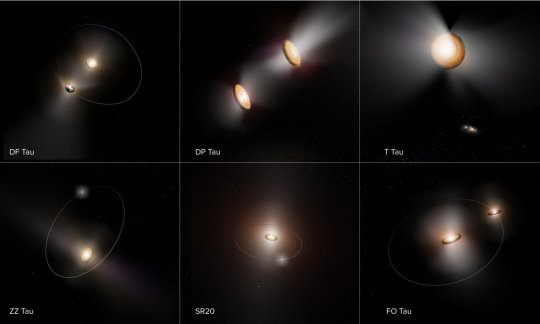
Double the disks, double the discovery: New insights into planet formation in DF Tau
Tucked away in a star-forming region in the Taurus constellation, a pair of circling stars are displaying some unexpected differences in the circumstellar disks of dust and gas that surround them. A new study led by researchers at Lowell Observatory, combining data from the Atacama Large Millimeter/submillimeter Array (ALMA) and Keck Observatory, has unveiled intriguing findings about planet formation in this binary star system, known as DF Tau, along with other systems in this region. The work is published in The Astronomical Journal.
DF Tau consists of two young stars with nearly equal masses, orbiting each other every 48 years. Since both stars likely formed together, with the same composition in the same environment, astronomers would expect them to share other things in common, like having similar circumstellar disks. But this is not the case—while the brighter, primary star has an active inner disk, the secondary star's inner disk appears to have almost completely disappeared. These unexpected differences challenge current theories of disk evolution and planet formation.
Just like a potter's wheel is used to shape clay into various forms, a circumstellar disk provides the materials and environment needed for planets to form. Over time, the dust and gas in the disk will clump together, eventually forming planets, moons, and other celestial bodies. The disks won't last forever—as a star matures, and planets form, the disk gradually disappears. So what caused the unusual dissipation observed in the circumstellar disk of the secondary star?
High-resolution ALMA imaging, combined with optical and infrared data from other telescopes, allowed researchers to study, analyze, and compare the properties of the stars and their individual disks. This binary has a relatively small, tight orbit, which means gravity truncates the outer parts of the disk, but it is unlikely that the current binary orbit could alter the inner disk. Instead, other processes may be at work.
"The dispersal of circumstellar disks is a complicated process with many unknowns. By looking at systems that form together, we can control one major variable: time. DF Tau and other systems in our survey tell us that disk evolution isn't strictly a function of time, other processes are at play," shares Taylor Kutra of Lowell Observatory, lead author of this research.
Binary systems like DF Tau, and other sources in this ALMA survey, offer a natural laboratory to study how circumstellar disks evolve. Understanding these processes is essential for refining models of planet formation because disk evolution sets the timescale on which planet formation occurs.
This research highlights the diversity of disk behaviors and underscores the need for further studies to unravel the factors influencing their lifespans and structures. These findings not only deepen our understanding of binary star systems but also shed light on the broader mechanisms shaping planetary systems across the galaxy.
IMAGE: Planet-forming disks in young multiple star systems. Credit: U.S. National Science Foundation/NSF National Radio Astronomy Observatory, B. Saxton
3 notes
·
View notes
Text
BEST AMBIENT OF 2024
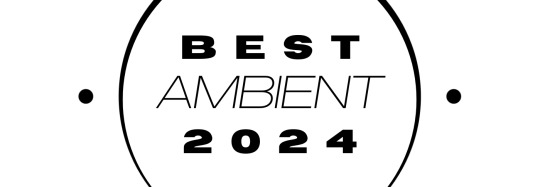
BEST AMBIENT ALBUMS of 2024 curated by @holsgr
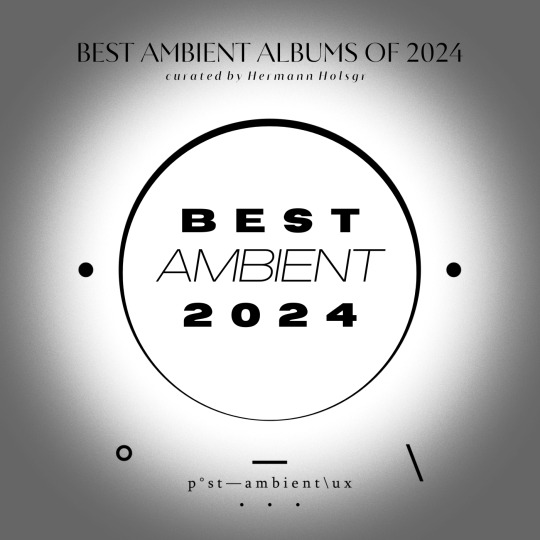
50 : Phexioenesystems - Tone Colour Garden Salmon Universe
49 : 0N4B - Somewhere, left behind 3XL
48 : Daigo Hanada & Yoko Komatsu - Where Clouds Are Born Moderna Records
47 : Ezra Feinberg - Soft Power Tonal Union
46 : Dawn Richard & Spencer Zahn - Quiet in a World Full of Noise Merge Records
45 : Hans Hjelm - Into The Night Self-release
44 : Olli Ahvenlahti - Mirror Mirror We Jazz Records
43 : Sachi Kobayashi - Lamentations Phantom Limb
42 : Sarah Neufeld, Richard Reed Parry & Rebecca Foon - First Sounds Envision Records / One Little Independent
41 : nonkeen - All good? LEITER
40 : PJS - Flora Dronarivm
39 : Félicia Atkinson - Space As An Instrument Shelter Press
38 : Anthéne - Cloudburst Home Normal
37 : Bremer/McCoy - Kosmos Luaka Bop Inc
36 : Princ€ss - Princ€ss wherethetimegoes
35 : G.S. Schray - Whispered Something Good Last Resort
34 : Jasmine Myra - Rising Gondwana Records
33 : YAI - Sky Time AKP Recordings
32 : ann annie - The Wind Nettwerk Music Group Inc.
31 : Seaworthy & Matt Rösner - Deep Valley 12k
30 : Marysia Osu - harp, beats & dreams Brownswood Recordings
29 : Fennesz - Mosaic P-VINE, Inc.
28 : Mary Lattimore & Walt McClements - Rain On The Road Thrill Jockey Records
27 : Glåsbird - A Sonic Expedition Whitelabrecs
26 : Iglooghost - Tidal Memory Exo LUCKYME®
25 : Ross Christopher & City Of Dawn - Spatio Temporal Amoveo Creative
24 : Arushi Jain - Delight Leaving Records
23 : Oliver Patrice Weder - The Shoe Factory Moderna Records
22 : Laura Masotto - The Spirit of Things 7K!
21 : Grand River & Abul Mogard - In uno spazio immenso light-years
20 : William Basinski - September 23rd Temporary Residence Ltd.
19 : Pub - Process The Wise ampoule records
18 : Altus - Ultraviolet Altus Music
17 : Seabuckthorn - This Warm, This Late quiet details
16 : Catherine Christer Hennix - Further Selections from The Electric Harpsichord Blank Forms Editions
15 : Antonina Nowacka - Sylphine Soporifera Mondoj
14 : Lori Goldston & Stefan Christoff - A Radical Horizon Beacon Sound
13 : Sam Wilkes - iiyo iiyo iiyo Self-release
12 : Slow Dancing Society - Do We Become Sky? Past Inside the Present
11 : Svaneborg Kardyb - Superkilen Gondwana Records
10 : Fergus McCreadie - Stream Edition Records
9 : Fabiano do Nascimento & Sam Gendel - The Room Real World Records
8 : Robert Rich & Luca Formentini - Cloud Ornament Self-release
7 : Ludwig Wandinger - Is Peace Wild? light-years
6 : Aidan Baker & Stefan Christoff - Januar Time Released Sound
5 : Hatti Vatti - Zeit R&S Records
4 : Larum - The Music of Hildegard von Bingen | Live at Public Records Puremagnetik
3 : Florian T M Zeisig - Planet Inc STROOM.tv
2 : Alva Noto - Xerrox, Vol.5 NOTON
1 : Lorenzo Montanà - VION n5MD
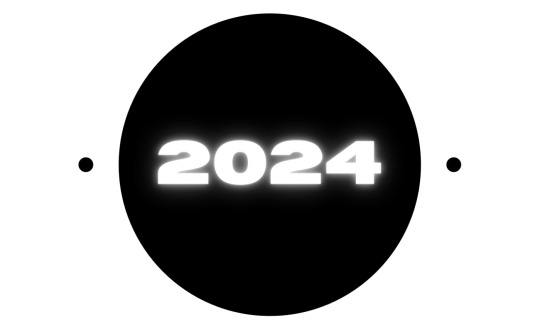
• BEST EP's 10 : Logic Moon & Henrik Meierkord - Ewiger Wald Dronarivm 9 : Roman Nagel - Home Bigo & Twigetti 8 : Snorri Hallgrímsson - Longer shadows, softer stones Deutsche Grammophon GmbH 7 : Oliver Patrice Weder - Grand Piano Works - Vol. II Moderna Records 6 : Wil Bolton - Quiet Sunlight Dronarivm 5 : Thaddeus - Orbiting Dreams Shimmering Moods Records 4 : PHI-PSONICS - Morning Sun / Arrival Gondwana Records 3 : Jeroen Dirrix - Feel Moderna Records 2 : Max Ananyev - Wings & Winds Self-release 1 : Arborra - Arborra 7K!
• HONORABLE MENTIONS Nicolas Jaar - Archivos de Radio Piedras Rafael Toral - Spectral Evolution Horacio Vaggione - Schall / Rechant Laura Misch - Sample The Earth Oliver Coates - Throb, shiver, arrow of time Nils Frahm - Paris Nala Sinephro - Endlessness Adaa - …img… Lau Andersson - The Weeping Siege MatC - Utoscapes Olivia Belli - Intermundia Alaskan Tapes - Something Ephemeral Mike Nigro - Leaving/Returning Michael Scott Dawson - The Tinnitus Chorus Bill Laurance & The Untold Orchestra - Bloom Bill Laurance & Michael League - Keeping Company Vegyn - The Road to Hell Is Paved with Good Intentions Shay Hazan - Wusul وصول Sam Gendel & Sam Wilkes - The Doober Blake Lee - No Sound In Space T.R. Jordan - Dwell Time II Perila - Intrinsic Rhythm Tristan Arp - a pool, a portal Lynn Avery & Cole Pulice - Phantasy & Reality Matthew Ottignon - Volant Holy Tongue & Shackleton - The Tumbling Psychic Joy of Now
• BEST REISSUES Fennesz - Venice 20 Aphex Twin - Selected Ambient Works Volume II [Expanded Edition]

#ambient#ambient music#best ambient music#best music of the year#best music of 2024#best of 2024#year-end list#best ambient#best music#bandcamp#best albums#best albums of 2024
6 notes
·
View notes
Text
[ Directional Orbit: Light ]
F2P alt runs – used up 3/3 of the allotted daily keys today! We went from Stage 48 to clearing stage 50 for the "Stars From Beyond" sole!!



Stage 48 was a frenzy stage. cleared with Lightseeker using Hunter Wand.
1-R protocore: +6
3-SR protocores: +0, +3, +3
8-SSR protocores: +0. +3, +3, +3, +3, +3, +3, +3
Stage 49 had the same protofield stellactrum as Stage 48, so I used the same team and stat attributes as above to clear this stage via auto battle.



We made it to Xavier's Directional Orbit - Stage 50! In addition to the 40 diamonds + 1 Empyrean Wish + 4000 gold, clearing this stage gives you the personal title "Stars From Beyond" sole!!


Stage 50 - Team 01 cleared with Lightseeker Companion using Luminescence Blade.
1-R protocore: +3
4-SR protocores: +0, +0, +3, +6
7-SSR protocores: +0, +0, +3, +3, +3, +3, +3


Stage 50 - Team 02 cleared with Lightseeker Companion using Hunter Claymore.
1-R protocore: +6
4-SR protocores: +0, +3, +3, +3
7-SSR protocores: +0, +0, +3, +3, +3, +3, +3
#love and deepspace#deepspace trials#directional orbit light#;not me rambling into the void#;smol meows
4 notes
·
View notes
Text
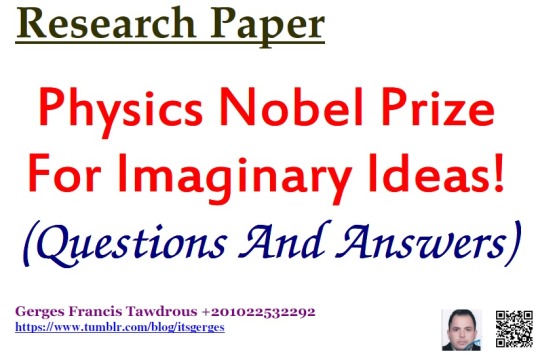
Best Greetings
Physics Nobel Prize For Imaginary Ideas! (Questions and answers)
or
Abstract
The Questions
The Paper Answers The Following Questions
Question no. (1)
Can The Sun Be Created After All Planets Creation?
Question no. (2)
Newton Theory Of The Sun Gravity Is Wrong (The Theory Refutation)
Question no. (3)
Did Einstein Misuse Lorentz transformation?
Question no. (4)
Planet Diameter Is Created As A Function In The Rotation Period
Question no. (5)
Can The Solar System Be Created From Light Beam Energy?
Question no. (6)
The Mass Gravity Can NOT Cause Any Motion (Newton is wrong)
Question no. (7)
How Is Planet Orbital Distance Defined?
Question no. (8)
Can The Solar System Be One A Continuum Of Data?
Question no. (9)
Can We Explain The Earth And Pluto Data Consistency?
Question no. (10)
How Is Planet Data Created?
Question no. (11)
Einstein hypothesis tells (The speed of light 300000 km/s is the universe limit velocity)- This Hypothesis Is Wrong – Why?
Question no. (12)
How Can Relativistic Effects Be Found In The Solar System?
Question no. (13)
The Planets Motions Use Different Rates Of Time
Question no. (14)
Can One Hour Of The Sun Clock = 365 Hours Of The Earth Clock?
Question no. (15)
Can The Motion Be Transported Among The Planets (A Summarized Idea)?
Question no. (16)
Can Mercury Day Period Disproves The Solar System Classical Vision?
Question no. (17)
The Sun Is The Solar System Motion Energy Outlet
Question no. (18)
Can Mars Cause the Earth moon creation? (Giant-Impact Hypothesis Is Wrong)
Question no. (19)
How Does The Solar System Work?
Question no. (20)
The Gravitational Waves Are Produced By The Planets Motions Energies
Question no. (21)
The Space Has Mechanical Features
Question no. (22)
The Planet Diameter Is Created By A Mathematical Equation
Question no. (23)
The Sun Is Not Doing Nuclear Fusion To Produce Its Rays
Question no. (24)
NO Tidal Locking Has Effect On The Moon Motion
Question no. (25)
Mars Itself Caused To Create The Earth Moon
Question no. (26)
Mars Will Collide With The Earth And Cause The Greatest Catastrophe In History
Question no. (27)
A research paper (Physics Nobel Prize For Imaginary Ideas!) - Paper objective
Question no. (28)
The idea tells (Venus Rotation Period was = Venus Orbit Period=243 days) is a proved fact by the planets data-
Question no. (29)
How Does The Observer Determine The Experiment?
Question no. (30)
Can Any Motion In The Solar System Moves By The Planets Velocities Total?
Question no. (31)
Major Refutations Are Found For The Theory Tells (The Sun Rays Is Produced By The Nuclear Fusion)
Question no. (32)
Why Is The Orbital Apogee Radius = 406000 Km?
Question no. (33)
How Is Planet Velocity Defined?
Question no. (34)
The Matter Is NOT Motionless By Nature (My Conclusion)
Question no. (35)
Can A Velocity 1.16 Million Km Per Second Be Found?
Question no. (36)
How Is The Solar Planet Created?
Question no. (37)
Why Do The Planets Motions Use Different Rates Of Time?
Question no. (38)
Can The Matter Dimensions Be Effected By Historical Factors?
Question no. (39)
The Sun Is A Phenomenon (No Planet Moves By The Sun Gravity)
Question no. (40)
How Does Planet Move? (The Mass Gravity Can't Cause Any Motion)
Question no. (41)
Speed of light is NOT the universe velocity limit (Einstein Is Wrong)
Question no. (42)
Can The Time Be Created In Units (24 Hours)?
Question no. (43)
All Distances In The Solar System Are Created Depends On Each Other
Question no. (44)
Planet Diameter Equation Proves Mars Is A Migrant Planet
Question no. (45)
Why Must The Gravitational Waves Be Created By The Planets Motions Energies?
Question no. (46)
Can All Planets Axial Tilts Be Created By One Motion?
Question no. (47)
Planet Velocity Is A Function In Speed Of Light
Question no. (48)
Can We Understand Lorentz Transformations?
Question no. (49)
Why Does We See The Sun Disc= The Moon Disc?
Question no. (50)
Can The Planets Motions Be Parts Of One Unified Motion?
Question no. (51)
Can The Dinosaurs Be Killed By The Gas Suffocation?
Question no. (52)
Jupiter Defines The Sun Position In The Sky
Question no. (53)
Can A Life Be Found On Mars In Ancient Time?
Question no. (54)
Why Does Venus Have No Moon?
Question no. (55)
Nature Of Space And The Gravitational Waves Source
Question no. (56)
The Solar System Creation Facts And Details
Question no. (57)
The Sun Rays Is Created By The Planets Motions Energies
Question no. (58)
The Planets Motions Use Different Rates Of Time (More Details)
Question no. (59)
Planets Data Analysis Is The Best Astrophysics Research Method
Question no. (60)
Planet Diameter Equation Test And Discussion (More Details)
Question no. (61)
How Can We Explain The Planets Distribution Between The Sun And Pluto?
Question no. (62)
Why Don't We Understand The Solar System Motion? Clearly The Real Geometry Isn't Understood By Any One?
Question no. (63)
Can Speed Of Light Have An Effect On The Matter Dimensions Definition?
Question no. (64)
Does The Sun Create A Gravitational Field?
Question no. (65)
What Mystery Can Be Solved By The Hypothesis (Matter Creation Depends On Speed Of Light)?
Question no. (66)
The Summary Of The Solar System Creation And Motion Theory
Question no. (67)
Can One Model Describe All The Universe Phenomena?
Question no. (68)
Can The Universe Be A Mirror?
Question no. (69)
Can The Matter Be Created Out Of The Space Energy?
Question no. (70)
What's the Earth motion effect on the observer Vision? (shortly, if the Earth stops its motion completely what changes will be happened for the universe vision?)
Question no. (71)
Can The Particle Nature Be Defined Without The Observer Effect?
Paper Reference
Physics Nobel Prize For Imaginary Ideas!
or
Gerges Francis Tawdrous +201022532292
Physics Department- Physics & Mathematics Faculty
Peoples' Friendship university of Russia – Moscow (2010-2013)
Curriculum Vitae https://www.academia.edu/s/b88b0ecb7c
E-mail [email protected], [email protected]
ORCID https://orcid.org/0000-0002-1041-7147
Facebook https://www.facebook.com/gergis.tawadrous
VK https://vk.com/id696655587
Tumblr https://www.tumblr.com/blog/itsgerges
Researcherid https://publons.com/researcher/3510834/gerges-tawadrous/
Google https://scholar.google.com/citations?user=2Y4ZdTUAAAAJ&hl=en
Livejournal https://gerges2022.livejournal.com/profile
Pocket https://getpocket.com/@646g8dZ0p3aX5Ad1bsTr4d9THjA5p6a5b2fX99zd54g221E4bs76eBdtf6aJw5d0?src=navbar
PUBLICATIONS
box https://app.box.com/s/47fwd0gshir636xt0i3wpso8lvvl8vnv
Academia https://rudn.academia.edu/GergesTawadrous
List of publications http://vixra.org/author/gerges_francis_tawdrous
Slideshare https://www.slideshare.net/Gergesfrancis
#физика#математика#астрономия#наука#геометрия#космос#электричество#механика#философия#астрофизика#решение задач#школа#10 класс#ошибки#учеба#physique#astronomy#quantum physics#квантовая физика#physics#astrophysics#астрономи космос наука#наш физик легенда#mathematics#math#maths#calculus#logic#science#planetary science
5 notes
·
View notes
Text
SCIENCE NEWS
Your last-minute guide to Monday's total solar eclipse
SHARE THIS —
April 4, 2024, 5:59 PM EDT / Updated April 5, 2024, 4:15 PM EDT
By Denise Chow and Lucas Thompson
A total solar eclipse will cross North America on Monday, offering millions a rare opportunity to see afternoon skies temporarily darken as the moon blocks the face of the sun.
Tune into NBC News NOW as Lester Holt hosts a two-hour special at 2 p.m. ET Monday from Indianapolis Motor Speedway.https://8c72a564604f613854c18f3f70fe4dd4.safeframe.googlesyndication.com/safeframe/1-0-40/html/container.html?n=0
The eclipse's path fortuitously cuts across Mexico, 15 U.S. states and a small part of eastern Canada. In all other states in the continental U.S., viewers will be treated to a partial solar eclipse, with the moon appearing to take a bite out of the sun and obscuring part of its light.
Here’s everything you need to know about the rare celestial event.
What is a solar eclipse?
Solar eclipses occur when the sun, moon and Earth align. The moon passes between Earth and sun, temporarily blocking the sun’s light and casting a shadow on Earth.
Solar eclipses occur only with the new moon. Because the moon’s orbit around Earth is tilted, the three bodies don’t always line up in a way that creates an eclipse.https://8c72a564604f613854c18f3f70fe4dd4.safeframe.googlesyndication.com/safeframe/1-0-40/html/container.html?n=0
“Imagine if the moon’s orbit were in the plane of Earth’s orbit around the sun — if that were the case, then every new moon, you’d have a total solar eclipse and every full moon, you’d have a lunar eclipse,” Neil DeGrasse Tyson, director of the Hayden Planetarium at the American Museum of Natural History, told NBC News. “So, because things don’t always align, it lends to the rarity of the event and the specialness of the event.”
Where and when will the eclipse be visible?
This year’s eclipse will follow a slightly wider path over more populated areas of the continental U.S. than other total solar eclipses have in the recent past.
The path travels through Texas, Oklahoma, Arkansas, Missouri, Illinois, Kentucky, Indiana, Ohio, Pennsylvania, New York, Vermont, New Hampshire and Maine. Tiny parts of Michigan and Tennessee will also be able to witness totality if conditions are clear.https://8c72a564604f613854c18f3f70fe4dd4.safeframe.googlesyndication.com/safeframe/1-0-40/html/container.html?n=0
After the eclipse crosses into Canada, it will pass over southern Ontario, Quebec, New Brunswick, Prince Edward Island and Cape Breton, at the eastern end of Nova Scotia.
Those outside the path of totality can still take part in the astronomical event by viewing a partial solar eclipse — visible throughout all 48 states of the contiguous U.S. — or a NASA livestream.
The timing, including how long totality lasts, depends on the location, but some spots will see the moon fully cover the sun for up to 4 minutes and 28 seconds.
Below is a list of timings for some cities along the path of totality, as provided by NASA. A number of other resources, including NationalEclipse.com and TimeandDate.com, can also help people plan.https://8c72a564604f613854c18f3f70fe4dd4.safeframe.googlesyndication.com/safeframe/1-0-40/html/container.html?n=0
Dallas: Partial eclipse begins at 12:23 p.m. CT and totality at 1:40 p.m.
Little Rock, Arkansas: Partial eclipse begins at 12:33 p.m. CT and totality at 1:51 p.m.
Cleveland: Partial eclipse begins at 1:59 p.m. ET and totality at 3:13 p.m.
Buffalo, New York: Partial eclipse begins at 2:04 p.m. ET and totality at 3:18 p.m.
Lancaster, New Hampshire: Partial eclipse begins at 2:16 p.m. ET and totality at 3:27 p.m.
It is never safe to gaze directly at the sun, even when it is partly or mostly covered by the moon. Special eclipse glasses or pinhole projectors are required to safely view solar eclipses and prevent eye damage. Failing to take the proper precautions can result in severe eye injury, according to NASA.
Eclipse glasses are thousands of times darker than normal sunglasses and specially made to enable wearers to look at the sun during these kinds of celestial events.https://8c72a564604f613854c18f3f70fe4dd4.safeframe.googlesyndication.com/safeframe/1-0-40/html/container.html?n=0
Sky-watchers should also never view any part of the sun through binoculars, telescopes or camera lenses unless they have specific solar filters attached. Eclipse glasses should not be used with these devices, as they will not provide adequate protection.
Beware of fake eclipse glasses. On legitimate pairs, the lenses should have a silver appearance on the front and be black on the inside. The manufacturer’s name and address should be clearly labeled, and they should not be torn or punctured. Check, as well, for the ISO logo and the code “IS 12312-2” printed on the inside.
If you don’t have eclipse glasses, you can make a homemade pinhole projector, which lets sunlight in through a small hole, focuses it and projects it onto a piece of paper, wall or other surface to create an image of the sun that is safe to look at. https://8c72a564604f613854c18f3f70fe4dd4.safeframe.googlesyndication.com/safeframe/1-0-40/html/container.html?n=0
All you need is two pieces of white cardboard or plain white paper, aluminum foil and a pin or thumbtack. Cut a 1- to 2-inch square or rectangle out of the center of a piece of white paper or cardboard. Tape aluminum foil over that cut-out shape, then use a pin or thumbtack to poke a tiny hole in the foil.
During the eclipse, place a second piece of white paper or cardboard on the ground as a screen and hold the projector with the foil facing up and your back to the sun. Adjusting how far you hold the projector from the second piece of paper will alter the size of the image on the makeshift screen
.What to look for while viewing the total solar eclipse
For people along the path of totality, there are some fun milestones to keep track of as the total solar eclipse unfolds.
When the last beams of sunlight are about to become obscured, look out for the “diamond ring effect”: The sun’s atmosphere will appear as an illuminated halo, and the last light still visible will look like the diamond of a giant ring.
As the sunlight decreases even further, an effect known as Baily’s beads will be created by the moon’s rugged terrain. Tiny “beads” of light will be visible for only a few seconds around the dark moon, as the last bits of sunlight peer through the moon’s mountains and valleys.
Some lucky sky-watchers may even catch a glimpse of a comet.
Comet 12P/Pons-Brooks — nicknamed the “devil comet” because an eruption last year left it with two distinct trails of gas and ice in the shape of devil horns — is currently visible from the Northern Hemisphere as it swings through the inner solar system.
The comet can be seen in the early evenings by gazing toward the west-northwest horizon. During the eclipse, when skies darken during totality, it may be possible to see the comet near Jupiter, but its visibility will depend on whether it’s in the middle of an outburst and thus brighter than normal.
Most likely, all eyes will be on the alignment of the moon and sun.
“Most people won’t even notice,” Tyson said. “But if you know to look, it’s there.”
When is the next solar eclipse?
The next total solar eclipse will be in 2026, but it will mostly pass over the Arctic Ocean, with some visibility in Greenland, Iceland, Portugal and northern Spain. In 2027, a total solar eclipse will be visible in Spain and a swath of northern Africa.
The next total solar eclipse visible from North America will be in 2033, but only over Alaska. Then in 2044, a total solar eclipse will cross Montana, North Dakota, South Dakota, parts of Canada and Greenland.
The next total solar eclipse to cross the continental U.S. coast-to-coast in will occur in 2045. The path of totality for that eclipse will cut through California, Nevada, Utah, Colorado, New Mexico, Oklahoma, Kansas, Texas, Arkansas, Missouri, Mississippi, Louisiana, Alabama, Georgia and Florida.
#Spotify#Lunar#earth and lunar show#sams earth#sun and moon show#tsams eclipse#eclipse#lunar eclipse#Lunar eclipse#eclipse season#moon magic#transits#worm moon#lunar eclipse au#mercury retrograde#lunar eclipse in libra#lunar eclipse 2024
2 notes
·
View notes
Text
The 100 (2014-2020)
Episode length: 39-42 min.
Country: USA
Genre: Science Fiction, Drama, Action, Adventure
Language: English
100 years in the future, when the Earth has been abandoned due to radioactivity, the last surviving humans live on an ark orbiting the planet — but the ark won't last forever. So the repressive regime picks 100 expendable juvenile delinquents to send down to Earth to see if the planet is still habitable.

Season 1
Episode 1: Pilot
Episode 2: Earth Skills
Episode 3: Earth Kills
Episode 4: Murphy's Law
Episode 5: Twilight's Last Gleaming
Episode 6: His Sister's Keeper
Episode 7: Contents Under Pressure
Episode 8: Day Trip
Episode 9: Unity Day
Episode 10: I Am Become Death
Episode 11: The Calm
Episode 12: We Are Grounders – Part I
Episode 13: We Are Grounders – Part II
Season 2
Episode 1: The 48
Episode 2: Inclement Weather
Episode 3: Reapercussions
Episode 4: Many Happy Returns
Episode 5: Human Trials
Episode 6: Fog of War
Episode 7: Long Into an Abyss
Episode 8: Spacewalker
Episode 9: Remember Me
Episode 10: Survival of the Fittest
Episode 11: Coup de Grace
Episode 12: Rubicon
Episode 13: Resurrection
Episode 14: Bodyguard of Lies
Episode 15: Blood Must Have Blood, Part One
Episode 16: Blood Must Have Blood, Part Two
Season 3
Episode 1: Wanheda: Part One
Episode 2: Wanheda: Part Two
Episode 3: Ye Who Enter Here
Episode 4: Watch the Thrones
Episode 5: Hakeldama
Episode 6: Bitter Harvest
Episode 7: Thirteen
Episode 8: Terms and Conditions
Episode 9: Stealing Fire
Episode 10: Fallen
Episode 11: Nevermore
Episode 12: Demons
Episode 13: Join or Die
Episode 14: Red Sky at Morning
Episode 15: Perverse Instantiation – Part One
Episode 16: Perverse Instantiation – Part Two
Season 4
Episode 1: Echoes
Episode 2: Heavy Lies the Crown
Episode 3: The Four Horsemen
Episode 4: A Lie Guarded
Episode 5: The Tinder Box
Episode 6: We Will Rise
Episode 7: Gimme Shelter
Episode 8: God Complex
Episode 9: DNR
Episode 10: Die All, Die Merrily
Episode 11: The Other Side
Episode 12: The Chosen
Episode 13: Praimfaya
Season 5
Episode 1: Eden
Episode 2: Red Queen
Episode 3: Sleeping Giants
Episode 4: Pandora's Box
Episode 5: Shifting Sands
Episode 6: Exit Wonds
Episode 7: Acceptable Losses
Episode 8: How We Get to Peace
Episode 9: Sic Semper Tyrannis
Episode 10: The Warriors Will
Episode 11: The Dark Year
Episode 12: Damocles – Part One
Episode 13: Damocles – Part Two
Season 6
Episode 1: Sanctum
Episode 2: Red Sun Rising
Episode 3: The Children of Gabriel
Episode 4: The Face Behind the Glass
Episode 5: The Gospel of Josephine
Episode 6: Memento Mori
Episode 7: Nevermind
Episode 8: The Old Man and the Anomaly
Episode 9: What You Take With You
Episode 10: Matryoshka
Episode 11: Ashes to Ashes
Episode 12: Adjustment Protocol
Episode 13: The Blood of Sanctum
Season 7
Episode 1: From the Ashes
Episode 2: The Garden
Episode 3: False Gods
Episode 4: Hesperides
Episode 5: Welcome to Bardo
Episode 6: Nakara
Episode 7: The Queen's Gambi
Episode 8: Anaconda
Episode 9: The Flock
Episode 10: A Little Sacrifice
Episode 11: Etherea
Episode 12: The Stranger
Episode 13: Blood Giant
Episode 14: A Sort of Homecoming
Episode 15: The Dying of the Light
Episode 16: The Last War
Watch on Netflix
#the 100#science fiction#drama#Action#Adventure#G#gay#gay characters#Bryan#nathan miller#Zev#Eric Jackson#B#bisexual#bisexual character#clarke griffin#Octavia Blake#L#lesbian#lesbian character#Lexa#Niylah
2 notes
·
View notes
Text
I was referencing the things put forth by OP, in order:
Huge wiring harnesses simplified: Cybertruck Guy and Radmad are both wrong, for different reasons.
Current industry standards don't have separate wires for each individual switch or control, either. They group several switches, lights, etc. that are nearby together, run them into a microcontroller, and put that controller on a vehicle bus. Currently that's usually a CAN (redundant, fault-tolerant) or LIN (neither, but much simpler) bus. This drastically simplifies wiring harnesses.
The main thing Tesla has done is change the DC voltage for that bus from 12 V to 48 V nominal. Since power is voltage times current, and wire thickness is dependent on current, this cuts about half the copper mass out of the power lines in the harness. The other (data) lines were already using smaller wires. The industry has been flirting with a 48V bus for around two decades by now; Tesla just went and did it and dealt with the engineering problems when they popped up. And this is a rare case where "they're a bunch of Silicon Valley nerds" may have helped: datacenters have been using 48V DC for in-rack power delivery for decades, so they had more familiarity with it than Detroit.
They've also adopted single-pair Ethernet (1000base-T1) for the high-speed entertainment data links. This technology has been in the industry since late 2016. It's usually integrated directly onto the custom ICs in ECUs. I remember another thread like this with a tweet where someone was complaining about the fragility of RJ-45 plugs and how that's disqualifying for a vehicle, and he's right, but single-pair Ethernet does not use those jacks; it's integrated into wiring harnesses with everything else.
Astronauts laded on the moon with altitude markers hand etched on the window: That was a backup system dramatized by the Apollo 13 movie. They had an inertial navigation system, like aircraft do, as their primary navigation.
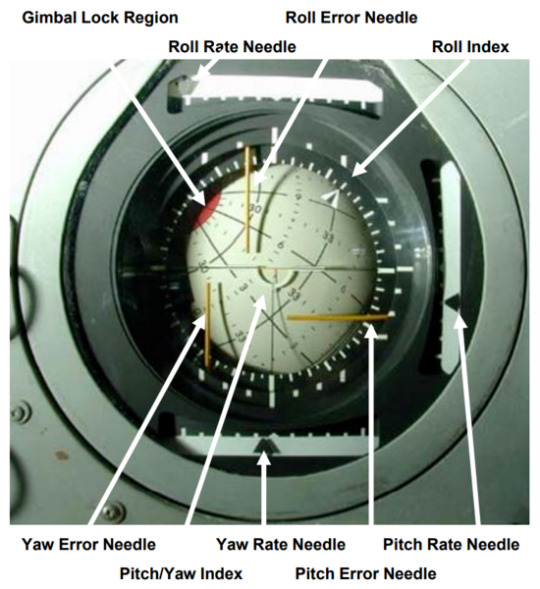
Oh, and it's attitude, not altitude. Very different concepts that folks should not mix up.
Can't get a rocket off the pad without blowing up: Neither could NASA their first few years. Meanwhile SpaceX had 98 successful orbital flights last year, and they can reuse their boosters (the record is 18 times). But that's way off topic.
Tesla Model Y broke: It's not news when non-Teslas lose power steering, apparently. And I've had cars that took many more than three appointments to fix. We can throw around anecdata all day.
Series wiring like Christmas lights: Come on, you've got no basis for that.
It's like the Titan sub: Sigh. Really?
Okay, now to the RDN link:
the vehicle’s angular design and stainless steel body could pose danger to other road users
Absolutely true. Also true of almost every luxury pickup truck on the market. One example:
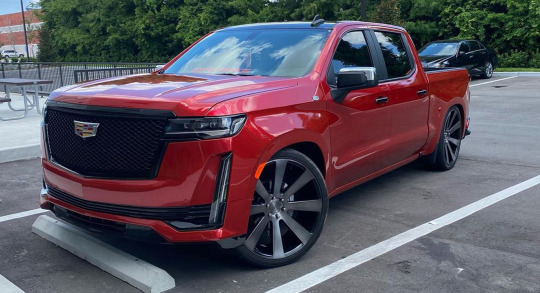
I'm all for figuring out some kind of regulatory regime to rein this in. Or maybe a modification of liability rules and increased insurance coverage minimums.
“The big problem there is if they really make the skin of the vehicle very stiff by using thick stainless steel, then when people hit their heads on it, it’s going to cause more damage to them,”
True, but it's not that thick or stiff; the speaker was speculating. Other have pointed out that "we shot it with a Tommy gun" is a lousy test because the bullets are rather low velocity. If you watch the side impact crash test, you can see the side panels visibly flexing.
And right after that, an IIHS rep said, “IIHS hasn’t evaluated the Cybertruck. The discussions we’ve seen so far appear to be based on speculation. I would add that our experience with Tesla is that they aim for the highest safety ratings in IIHS tests. We have no reason to expect anything different with the Cybertruck.”
The biggest problem with Teslas, from insurance companies' perspectives, has been that airbag-deployed collisions tend to result in totaling the vehicle more often than in other cars. Occupant safety, on the other hand, seems to be better than average. We've seen people walk away from their Model 3s after they got T-boned by speeding pickups (60-ish MPH in a 30 zone). We know this from accident reconstruction and camera data.
There's a linked video in the article comparing the Tesla Cybertruck collision to a Dodge Ram 1500. There are several others like it on YouTube (I saw one that had six trucks in it, all synced up). They all have the same flaw: they're comparing different crash types. The Cybertruck is doing a full frontal crash, where you drive the vehicle into a solid, immovable wall, while the others are moderate overlap crashes, where the hood goes over the obstacle and only the left 1/3 of the vehicle is obstructed, so the engine can deflect to the sides instead of going into the firewall and then the passenger compartment. The Cybertruck, of course, does not have a large engine in that space; it's mostly cargo storage. And we can clearly see it crumpling and the front wheel moving outward instead of back into the passenger compartment, like practically all cars do now.
(Some folks like to point out how the rear wheel breaks away, too: this is expected because it's a steering wheel, since the Cybertruck has four-wheel steering, and uses the same suspension technology as the front, instead of connecting the rear wheels more directly to the rear axle like most vehicles. Not completely directly, though, like the Chevy Corvair's swing axles. In any case, kinetic energy breaking the rear wheels off like that is energy that isn't compromising the cabin.)
The article addresses the "lack" of crumple zones:
Samer Hamdar, a George Washington University auto safety professor, told Reuters that while a lack of crumple zones concerned him, there could be other factors that accounted for it. “There might be a possibility of shock-absorbent mechanism that will limit the fact that you have a limited crumple zone,” Hamdar said.
I'm not going to speculate about crumple zones beyond the above ("the cargo area collapses, taking some energy with it; we have to see if that's enough to call a crumple zone, but it's not nothing") until someone tears one down and documents it. But crumple zones aren't the only means of keeping kinetic energy out of the passengers.
The rest of the article goes back to concerns about pedestrian safety, which seem to be the main substantive concern, and is noted at the end of this video:
youtube
And again, pedestrian safety is an industry-wide problem. We need another Ralph Nader, but demonizing Tesla alone (god it's so easy, Elon is such an asshole) only gives cover to the rest of the industry. And none of the tweets in OP's post spoke of this.
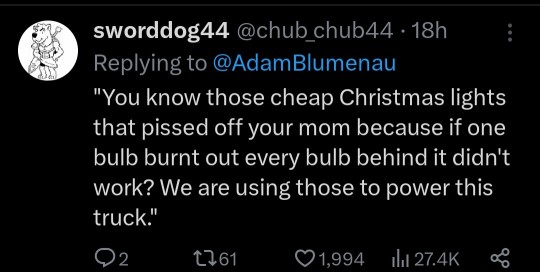
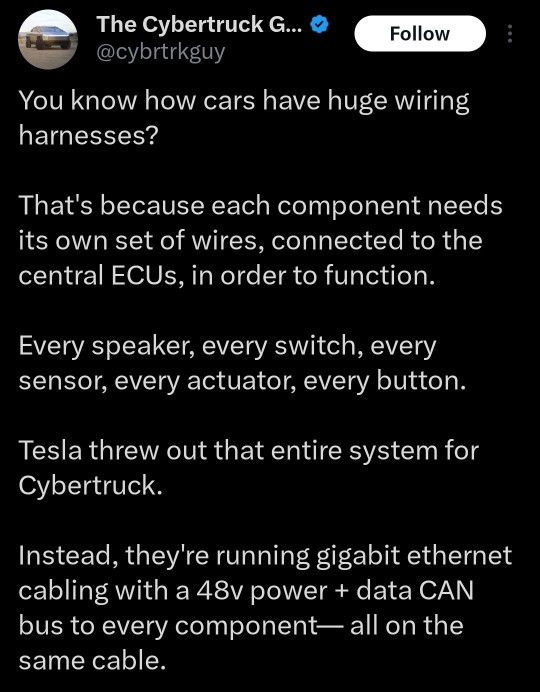
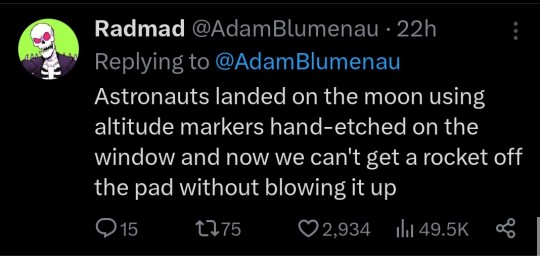
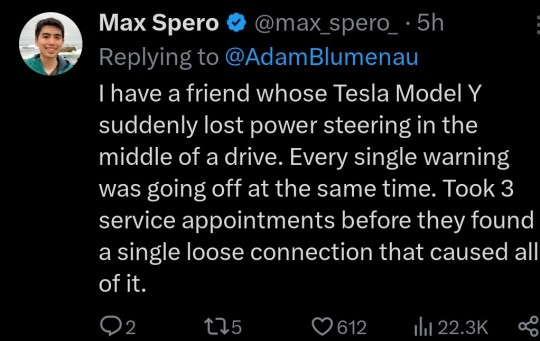
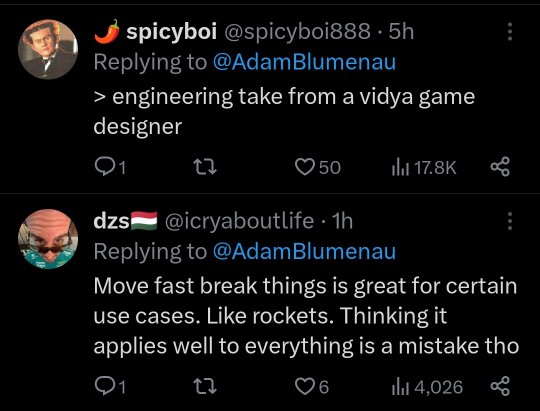
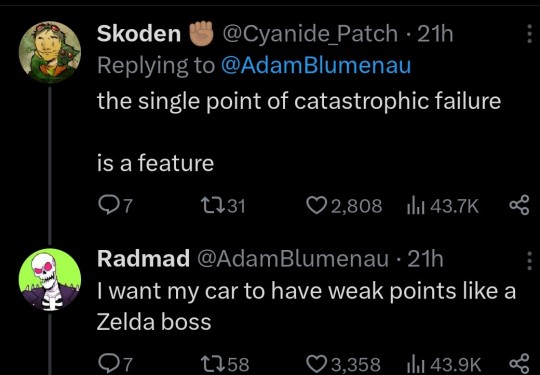

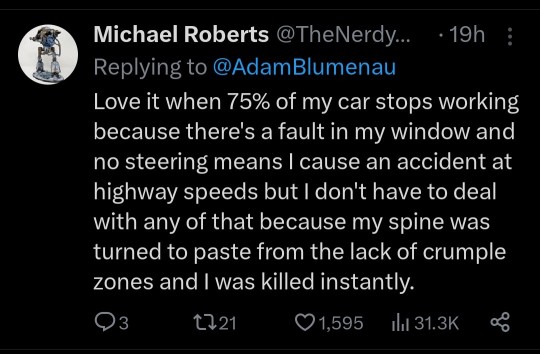
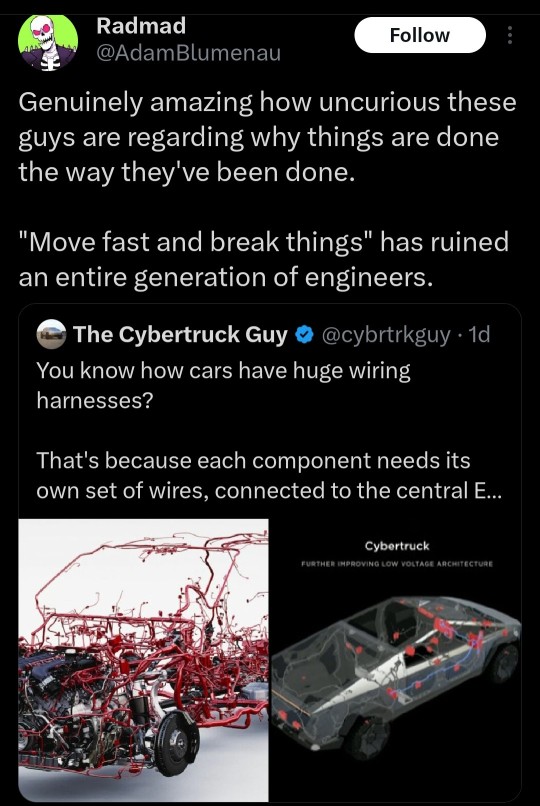
42K notes
·
View notes
Text
Here’s a curated list of 50 of the most highly awarded books from 2010 to 2025, based on major literary prizes (Pulitzer, Booker, National Book Award, Women’s Prize, etc.). I’ve grouped them by key awards for clarity:
---
🏆 Pulitzer Prize for Fiction
1. The Goldfinch by Donna Tartt (2014)
2. All the Light We Cannot See by Anthony Doerr (2015)
3. The Underground Railroad by Colson Whitehead (2017)
4. Less by Andrew Sean Greer (2018)
5. The Overstory by Richard Powers (2019)
6. James by Percival Everett (2025)
---
🎖 Booker Prize Winners
7. Bring Up the Bodies by Hilary Mantel (2012)
8. The Luminaries by Eleanor Catton (2013)
9. The Narrow Road to the Deep North by Richard Flanagan (2014)
10. A Brief History of Seven Killings by Marlon James (2015)
11. The Sellout by Paul Beatty (2016)
12. Lincoln in the Bardo by George Saunders (2017)
13. Girl, Woman, Other by Bernadine Evaristo (2019)
14. Orbital by Samantha Harvey (2024)
---
📖 National Book Award / National Book Critics Circle
15. The Sympathizer by Viet Thanh Nguyen (Pulitzer & Carnegie)
16. Americanah by Chimamanda Ngozi Adichie (NBCC)
17. The Nickel Boys by Colson Whitehead (2019)
18. Lincoln in the Bardo by George Saunders (2017)
---
🏅 Women’s Prize for Fiction
19. The Tiger’s Wife by Téa Obreht (2011)
20. The Song of Achilles by Madeline Miller (2012)
21. May We Be Forgiven by A. M. Homes (2013)
22. How to Be Both by Ali Smith (2015)
23. Home Fire by Kamila Shamsie (2018)
24. My Brilliant Friend by Elena Ferrante (2010s finalist)
25. Brotherless Night by V. V. Ganeshananthan (2024)
---
🧠 National Book Award (Young People’s Literature)
26. Ghost by Jason Reynolds (2016 finalist, NAACP honors)
27. Long Way Down by Jason Reynolds (2018)
28. Look Both Ways by Jason Reynolds (2019 finalist)
---
🌍 Giller, Governor General’s & International Awards
29. Do Not Say We Have Nothing by Madeleine Thien (Giller, GG, Booker shortlist)
30. The Overstory by Richard Powers (Pulitzer, Goodreads mentions)
---
🧭 Other Major Prize Winners
31. Demon Copperhead by Barbara Kingsolver (2023 Pulitzer)
32. Pachinko by Min Jin Lee (multiple, including women’s awards)
33. The Warmth of Other Suns by Isabel Wilkerson (many honors)
34. A Visit From the Goon Squad by Jennifer Egan (Pulitzer finalist and awards)
35. Sing, Unburied, Sing by Jesmyn Ward (Pulitzer finalist)
36. Little Fires Everywhere by Celeste Ng (awards mentions)
37. Fates and Furies by Lauren Groff (various honors)
38. The Tiger's Wife by Téa Obreht (Orange Prize)
39. Born a Crime by Trevor Noah (essential memoir honors)
40. The Immortal Life of Henrietta Lacks by Rebecca Skloot (many nonfiction awards)
41. Being Mortal by Atul Gawande (nonfiction awards)
42. The Seven Husbands of Evelyn Hugo by Taylor Jenkins Reid (cultural phenomenon)
43. Swamplandia! by Karen Russell (critically acclaimed)
44. The Woman in Cabin 10 by Ruth Ware (thriller awards)
45. The Emperor of All Maladies by Siddhartha Mukherjee (Pulitzer, nonfiction)
46. Hold Still by Patti Smith (NB Award)
47. White Trash by Nancy Isenberg (significant historical honors)
48. Just Kids by Patti Smith (National Book Award)
49. Mind Spread Out on the Ground by Cole Swensen (National Magazine Award gold)
50. The Road by Cormac McCarthy (Pulitzer 2007, still cited as major prizewinner)
---
🔍 Why These 50?
They span international recognition: Pulitzer, Booker, National, Women’s Prize, Giller, GGs.
They include highly decorated authors like Jason Reynolds, Colson Whitehead, Téa Obreht, and Donna Tartt.
Several have multiple awards or sweep across genres (fiction, nonfiction, YA).
---
This selection reflects the breadth and depth of literary excellence from 2010–2025. Want me to add short descriptions for any favorites or narrow by genre/theme?
0 notes
Text
Battletech: Tikonov Planetary Report
Merged Tikonov Planetary Report (Updated, 3025)
System Data:
Star Type: G2IV (Yellow Subgiant, ~10–15% brighter than Terra’s G2V Sun).
Position in System: 3rd planet (Tikonov III).
Distance from Star: ~1.15 AU.
Travel Time to Jump Point: ~9 days (1G acceleration).
Natural Satellites: None (confirmed, overriding chapter’s “triple moons”).
Orbital Peculiarity: Slight axial tilt and minimal seasonal variation; high solar irradiance at equator.
Recharging Station: Class B (High Military Traffic).
ComStar Facility Class: B (Strategic Monitoring Active).
System Notes: Tikonov orbits a transitioning G2IV subgiant, hotter and more intense than Sol, exacerbating desertification (e.g., Ufa Flats, Southern Craters). Its position, one jump from Mira and two from Capella, makes it a strategic frontier world in the Capellan Confederation, near the Federated Suns border, frequently raided (e.g., 2987 Davion siege).
Stellar and Atmospheric Aesthetics The G2IV star’s intense golden-white light creates vivid colors and sharp shadows, with dust-laden air producing fiery orange-magenta sunsets. The moons—Andropov (largest, half Luna’s size), Andruyev, and Ashkilov—cast a luminous, layered glow, with Andropov’s silver light dominating. Their dynamic orbits make nights vibrant, blending with Tikograd’s industrial haze for a futuristic sheen.
Planetary Data:
Diameter: 12,400 km.
Gravity: 1.1g (10% higher than Terra’s 1g).
Atmosphere: Standard pressure, arid (low moisture content), breathable but laden with particulate matter from dust storms and industrial output (e.g., Tikograd’s “industrial haze”).
Hydrosphere: 48% water (mostly shallow inland seas and hyper-salinated lakes).
Surface Temperature Averages:
Temperate zones: 18–22°C.
Equatorial deserts: 40–48°C (peak summer), low humidity.
Precipitation: 300–500 mm/year (limited to coastal belts and mountain runoff).
Major Terrain Features:
Ufa Dust Flats: Salt basin, frequent storms, hyper-arid (<100 mm/year).
Krasnodar Ridge: Source of limited river systems, supporting agriculture (grain, fish).
Pskov Lowlands: Primary agricultural zone, heavily fortified, Mediterranean-like climate (500–700 mm/year).
Southern Craters: Desertified region, impacted by G2IV star’s heat.
Mountains (Kazan, Bulun): Bare and arid in rain shadows (e.g., east/northeast of Bulun), with sparse woods on wet slopes (400–600 mm/year).
Bulun Jungle (Southwest): Thick equatorial jungle, tropical rainforest climate (2,000–2,500 mm/year).
Percentage and Level of Native Life: <10% surface terrestrial analogs (mostly desert-adapted flora); native animal life extremely sparse.
Environmental Notes: Tikonov’s environment is functionally hostile. The 1.1g gravity and low-moisture atmosphere strain residents and visitors, with dust storms (seasonal, severe near Tikograd and Bulun) limiting outdoor activity. Protective gear is common, and the G2IV star’s heat drives desertification, particularly in Ufa Flats and Southern Craters.
Population:
Total: ~5.5 million, sparsely distributed due to harsh conditions, 1.1g constraints, war-induced emigration, and frontier threats.
Urban: 300,000–400,000 across ~10 major cities, centered in fortified, compact settlements along rail/water lines:
Tikograd (Capital, Kazan): 150,000–250,000. Home of Earthwerks Ltd. (BattleMech production, notably Vindicators), planetary military HQ. Pollution-choked, heavily fortified, divided by caste and function (administrative, industrial, residential sections), surrounded by defensive walls, towers, and industrial buffer zones (parklands).
Bulun: 30,000–40,000 (20,000 within walls, rest in slums). Western desert bastion near equator, famous for withstanding Crucis Lancers siege (2987). Fortified port city with ferrocrete walls, autocannon/laser towers.
Pskov, Krasnodar: Farming and mining towns, highly militarized, 20,000–40,000 each. Pskov Lowlands and Krasnodar Ridge support agriculture (grain, fish).
Rural: ~5 million, agrarian belt (Pskov, Krasnodar) and semi-nomadic settlements (Ufa deserts), supporting food and raw materials.
Urban Density Note: Settlements are compact, walled, and arranged along rail/water lines, with anti-air emplacements and sealed shelters due to historical bombardments.
Militia: 80,000 (14.5 per 1,000), mostly local, reflecting martial necessity against Federated Suns raids (e.g., 2987 siege, Crucis Lancers at Bulun).
Emigration Trends: Harsh environment (dust storms, haze, heat), 1.1g health strains (respiratory issues, joint pain), and constant attacks drive emigration. Nobility and non-essential workers flee to safer worlds like Mira (0.9g, 40-day round trip via DropShip and Jump), leaving Tikonov with essential workers for factories (e.g., Earthwerks).
Post-Apocalyptic Context: 3rd Succession War (2866–3025) devastation—orbital bombardments, WMDs, famine, supply chain collapse—has reduced Tikonov’s population, mirroring Inner Sphere-wide depopulation (akin to post-Black Plague Europe, amplified by interstellar collapse). A Mad Max-like setting, barely functional, with sparse millions tethered to industrial output and survival.
Climate Model:
Global Overview: Hot, arid (average 18–22°C), low precipitation (300–500 mm/year), driven by G2IV star’s high solar irradiance. 1.1g amplifies winds (20–40 km/h), spreading dust from deserts. Slight axial tilt causes minimal seasonal variation, with equatorial zones (Bulun) experiencing high heat and monsoons.
Regional Breakdown:
Bulun (Equatorial, Southern Coast): Tropical rainforest climate (Singapore analog), 28–35°C year-round, 2,000–2,500 mm/year rainfall, 85–95% humidity. Thick jungle southwest (biodiversity hotspot, shorter trees due to 1.1g), arid mountains east/northeast (<200 mm/year, 15–25°C). Monsoon winds (15–25 km/h).
Tikograd (Kazan, Mid-Latitude): Semi-arid, hot summers (35–42°C), mild winters (5–10°C), 400–500 mm/year rainfall. Dust storms from Ufa mix with Earthwerks’ emissions, creating “industrial haze.” Parklands between fortified sections are dry, minimally irrigated.
Ufa Dust Flats: Hyper-arid desert, 40–48°C summer, 0–5°C winter, <100 mm/year. Severe dust storms (30–50 km/h), rare flash floods (every 5–10 years).
Pskov Lowlands/Krasnodar Ridge: Mediterranean-like, 20–30°C, 500–700 mm/year, wet winters, dry summers. Supports agriculture (grain, root vegetables, fish, algae-derived proteins), heavily fortified.
Mountains (Kazan, Bulun): 10–25°C, 400–600 mm/year, sparse woods on wet slopes, arid in rain shadows.
Southern Craters: Desertified, 40–48°C, exacerbated by G2IV star’s heat.
Weather Phenomena: Dust storms (deserts, especially Ufa), flash floods (mountains), monsoons (Bulun), industrial haze (Tikograd).
Impact on Living Conditions: Harsh climate and 1.1g strain health, making Tikonov undesirable for families, driving emigration to Mira. Protective gear is common due to dust storms, particularly near Tikograd and Bulun.
Economy & Industry:
Primary Economic Activities:
Industrial Output (Tikograd): Earthwerks BattleMech production (notably Vindicators), internal logistics manufacture (myomer fiberworks, armature plating).
Agriculture: Grain, root vegetables, algae-derived proteins (Krasnodar basin, Pskov Lowlands), requires irrigation, largely government-subsidized.
Raw Materials: Limited ferrous and rare earths; mining occurs at high environmental cost (e.g., dried lakebeds near Pskov).
Hydrocarbons: Extracted near Pskov and dried lakebeds, mostly reserved for industrial use.
Economic Notes: Labor is tightly controlled by Capellan state corporations or noble absentee landlords, mirroring late 19th-century factory states—exploitative but stable due to necessity. Most off-world exports are military or industrial, supporting the Confederation’s war efforts.
Logistics and Infrastructure:
Transport Constraints: 1.1g increases fuel consumption and wear, making road/air transport uneconomical. Vehicles burn 10–15% more fuel, aircraft are rare (military VTOLs only).
Rail and Water Dominance: Rail (Tikograd subways, inter-city lines) and water (ports in Bulun, Pskov, Krasnodar) are primary transport modes, supporting compact settlement patterns along rail/water lines.
Cultural Profile (Tikonov Tangent):
Cultural Base: Eurasian-Russian majority (Tikonov settlers), with a strong collectivist and survivalist ethos.
Martial Tradition: Reinforced through militia culture and compulsory military education; militia membership is a rite of passage (e.g., Starkov’s drills).
Religion & Philosophy: Secular-capitalist state ideology dominates; underground sects exist, with prevalence of ancestor reverence among rural populations.
Social Notes: Tikonov venerates labor, endurance, and defiance. Nobility, often resented, live off-world on Mira, leaving essential workers behind. Local festivals blend martial parades with harvest rituals, reflecting a society shaped by hardship and war. 1.1g influences physical norms (stocky builds, deliberate movements) and dress (corsets for women to brace against gravity, shaping beauty ideals), with further exploration pending.
Social Structure: Sparse population and emigration create a rigid hierarchy—essential workers in factories, farmers in fertile zones, and absentee nobles on Mira. Social mores emphasize resilience, discipline, and loyalty to the Confederation.
Physiological Effects of 1.1g Gravity
Muscular and Skeletal Adaptations Tikonov’s 1.1g gravity, 10% higher than Earth’s, exerts greater force on settlers’ bodies, driving physiological adaptations over centuries. Early colonists likely experienced fatigue and joint stress, but by 3025, multi-generational residents have adapted:
Increased Muscularity: Constant resistance from 1.1g promotes muscle hypertrophy. Settlers, especially laborers in Tikograd’s factories or Pskov’s farms, develop denser, stronger muscles, particularly in the legs, back, and core. Athletes and soldiers, like the Tikonov Lancers, exhibit builds akin to powerlifters, with enhanced endurance for manual tasks.
Skeletal Density: Bones adapt to higher stress, becoming thicker and denser to resist fractures. This reduces osteoporosis risk but makes settlers slightly stockier than Terran norms. Children born on Tikonov grow with these traits, their skeletons and muscles optimized for 1.1g.
Cardiovascular Adjustments: The heart works harder to pump blood against 1.1g, leading to stronger cardiac muscles and slightly elevated resting heart rates. Over centuries, settlers’ cardiovascular systems are more robust, though newcomers from 1.0g worlds may feel short of breath initially.
Other Physiological Impacts
Falls and Injuries: Falls at 1.1g are 10% more forceful, increasing bruise and fracture risk. Settlers move cautiously, and children learn to fall “softly,” fostering a cultural emphasis on agility training. Industrial safety protocols in Earthwerks factories prioritize harnesses and padded surfaces.
Metabolic Rate: Higher gravity slightly elevates caloric needs, as muscles work harder. Tikonov’s cuisine, rich in grains and proteins from Pskov, supports this, with hearty dishes like borscht or dumpling soups reflecting Russian-Chinese fusion.
Posture and Gait: Residents adopt a slightly forward-leaning posture to counter 1.1g, with a deliberate, grounded gait. This gives Tikonovians a distinctive “sturdy” appearance, celebrated in local art as a mark of resilience.
Military Significance:
Strategic Position: One jump from Mira, two from Capella, a frontier defense world in the buffer zone against Federated Suns.
Historical Conflicts:
2829–2987: Cyclical sieges from Federated Suns; occupation and rebellion cycles.
2987: Crucis Lancers siege of Bulun; successful Capellan resistance.
2995–2999: Local uprisings crushed by Maskirovka and Earthwerks-sponsored security forces.
Forces Present (3025):
Local Militia: ~80,000 (14.5 per 1,000 population).
Capellan Regulars: Rotating garrison battalions, often understrength, commanded by Colonel Ridzik in Tikograd.
Defensive Infrastructure: Tikograd features hardened bunkers, turrets, artillery rail platforms; Bulun has ferrocrete walls, autocannon/laser towers, and deep mountain emplacements (post-2987 upgrades). Armored and mechanized infantry defend Tikograd’s outer walls and parklands, with infantry in buildings/factories.
Military Notes: Tikonov is a fortress world in the guise of a factory hub. Its people, hardened by raids, dust, and neglect, embody a survivalist mindset. Bulun’s defenders leverage its industries, forcing close assaults to avoid collateral damage. “This is not a world you conquer easily. It’s a world you bleed to hold.”
Comparison to Other Worlds:
Menkalinan (Revised): 4 million natives (foresters), ~100,000–200,000 offworlders, 60,000 offworld militia. Harsh (twin suns, no night), less industrial than Tikonov.
Mira: 0.9g, sea-rich, a noble haven, contrasting Tikonov’s harshness, explaining emigration (40-day round trip).
Terra: Overpopulated (billions), unlike sparse colonies like Tikonov, depleted by Succession Wars.
Strategic Importance (3025):
Industrial Hub: Earthwerks’ mech production makes Tikonov a key Capellan asset.
Frontier Vulnerability: Proximity to Federated Suns invites raids, necessitating fortifications and militia.
Effects on Mech Combat
Tikonov’s 1.1g gravity, standard but slightly denser atmosphere, and arid conditions shape BattleMech combat, affecting movement, weaponry, and tactics. Below are the key implications:
Gravity and Movement
Falls and Stability: A 10% gravity increase makes Mech falls more damaging. A 65-ton Thunderbolt hitting the ground at 1.1g suffers greater stress on joints and actuators, raising maintenance costs. Pilots avoid risky maneuvers on uneven terrain, like Kazan’s rocky hills, favoring stable footing on Pskov’s plains. Jump-capable ‘Mechs (e.g., Cataphract) face higher landing impacts, requiring reinforced leg actuators.
Speed and Agility: Higher gravity reduces sprint speeds and jump distances by ~10%. Light ‘Mechs like the Locust lose some nimbleness, while heavy ‘Mechs feel sluggish. CCAF pilots train for precision over speed, using Tikonov’s flatlands for ambushes rather than chases.
Ballistic Weapons
Shorter Ranges: In 1.1g, ballistic projectiles (e.g., autocannon rounds, missiles) follow steeper trajectories, reducing effective range by ~5–10%. An AC/5’s 540-meter range on a 1.0g world drops to ~490–510 meters. Gunners adjust targeting computers for Tikonov’s gravity, but long-range engagements are less effective, favoring close-in brawls.
Recoil and Stability: Recoil feels 10% stronger, stressing Mech frames. Pilots brace heavier ‘Mechs like the Thunderbolt to absorb autocannon kick, while lighter ‘Mechs risk tipping if poorly balanced.
Atmospheric Density and Effects
Density: Tikonov’s “standard” atmospheric pressure, likely similar to Earth’s (1 atm), may be slightly denser due to 1.1g compressing the atmosphere closer to the surface. This increases drag on projectiles and slightly enhances sound propagation.
Sound Propagation: Sound travels farther and clearer in a denser atmosphere. MechWarriors hear autocannon fire or ‘Mech footsteps from greater distances, improving situational awareness but making stealth harder. In Tikograd’s urban sprawls, echoes amplify, complicating audio sensors.
Laser Range: A denser atmosphere scatters laser beams more, reducing effective range by ~5%. A large laser’s 450-meter range on a 1.0g world with thinner air might drop to ~425 meters. Dust from Tikonov’s arid climate exacerbates this, especially during Pskov dust storms, where laser accuracy plummets. Energy-based ‘Mechs (e.g., Hunchback with PPCs) lose some edge, pushing CCAF tactics toward ballistic-heavy designs like the Cataphract.
Heat Dissipation: The denser atmosphere improves convective cooling slightly, aiding heat management. ‘Mechs with high-heat weapons (e.g., PPCs) overheat less quickly, though arid heat (29°C) offsets this in prolonged battles.
Tactical Implications
Terrain Advantage: CCAF forces leverage Tikonov’s flat plains for stable footing and urban areas like Tikograd for cover, mitigating gravity’s impact on mobility. Federated Suns raiders, used to 1.0g worlds, struggle with falls and reduced weapon ranges, giving defenders an edge.
Weapon Mix: Tikonov’s garrison favors ballistic-heavy ‘Mechs (e.g., Thunderbolt) for close-range engagements, as autocannons and SRMs are less affected by atmospheric scattering than lasers. Missile boats like the Catapult adjust for shorter LRM ranges but benefit from denser air stabilizing flight paths.
Pilot Training: MechWarriors train in 1.1g simulators, building endurance for heavier G-forces during maneuvers. Neurohelmet feedback is tuned to compensate for denser air’s sensory overload (e.g., louder sounds).
Environmental Factors: Dust storms on Pskov or Ufa reduce visibility and laser efficacy, forcing reliance on radar and ballistics. Coastal battles near Krasnodar risk “Triple Tide” floods, bogging down heavy ‘Mechs in mud.
Cultural and Combat Aesthetic Tikonov’s Mech battles under the G2IV’s intense light and moonlit nights are visually striking. Daytime engagements on Pskov’s plains shimmer with dust and laser flashes, while night battles under Andropov’s glow cast ‘Mechs in silvery relief. The heavier gravity makes each step feel deliberate, with pilots describing a “grounded” rhythm to combat. Locals joke that Tikonov’s ‘Mechs “hit harder, fall harder,” reflecting both pride and the planet’s unforgiving physics.
0 notes
Text
The JFK Files: A Conversation with Grok, March 2025
Intro: The 2025 JFK File Release
On March 21, 2025, I asked Grok, built by xAI, about the latest JFK assassination files, released on March 18 per Trump’s directive. Grok kicked off with the basics: 80,000 pages, mostly FBI and CIA docs, with more still being digitized. No earth-shattering reveals, just more texture—Oswald’s Mexico City trip, CIA surveillance, mafia whispers—but the lone-gunman story holds, officially. I wasn’t sold; Trump hinted at holding back something big, and the mystery felt alive. Grok agreed: gaps and redactions keep conspiracy flames burning.
Oswald as a Patsy: The CIA Angle
I floated a theory—Oswald was framed, maybe by the CIA, who’d watched him since his Soviet days. Grok ran with it: his 1963 Mexico City embassy visits were tracked, his pro-Castro stunts in New Orleans CIA-monitored. Why kill JFK? Bay of Pigs fallout, JFK’s distrust of the agency, Cold War stakes. Oswald’s “I’m a patsy” cry hours after his arrest—November 22, 1963—felt legit to me. Grok nodded: his quick death by Ruby 48 hours later screamed loose-end cleanup.
The Rifle and Tippit Murder: Evidence or Setup?
I drilled into Oswald’s rifle—a Mannlicher-Carcano with his prints, bought via mail order. Found on the Depository’s sixth floor, tied to JFK’s death. But the Tippit killing 45 minutes later? Four shells from his .38 revolver, dumped at the scene—odd for a revolver, which doesn’t eject. Grok dug in: witnesses saw him “shaking” it out, but why leave a trail mid-flight? Ballistics wobbled—one bullet didn’t match. Either sloppy Oswald or planted evidence. Fishy as hell.
Ruby’s Role: Mob Puppet or Lone Nut?
Ruby’s November 24 basement hit—live on TV, point-blank—didn’t add up. “Spare Jackie a trial”? I called BS; Grok backed me. Ruby owed mob cash—Trafficante ties in the 2025 files. A kamikaze move for a light sentence (5 years?) makes sense if they leaned on him: “Do it or else.” A tip predicted Oswald’s murder a day early. Crime of passion? More like coerced cleanup. The mob-CIA Castro plots overlapped—ironic if they nailed JFK instead.
Ruth Paine: Innocent or Linchpin?
Ruth Paine tipped Oswald to the Depository job October 16, 1963—six weeks pre-motorcade (set November 18). His rifle sat in her garage. Coincidence? I said odd; Grok agreed. CIA might’ve tapped her—Russian studies, émigré ties, husband’s defense gig. No proof she’s dirty, but the stars aligned too neat—job and gun, her orbit. Pawn or plant, she’s key to the frame if Oswald’s not the shooter.
The Setup Theory: Oswald Duped
Oswald grabbed the rifle November 21, per Marina—hours before the hit. I flipped it: what if he didn’t? Marina and Frazier (the “curtain rods” driver) coerced or lying? Grok ran it: CIA knew the rifle’s spot, Oswald’s perch, the route. A last-minute plant, Oswald’s there by chance—hired pre-route for legit cash. “Patsy” fits a guy duped, not despairing. The 2025 files deepen CIA eyes on him, mob on Ruby—evil intent if they pounced.
The Mystery Endures
Will we ever know? I doubted it; Grok echoed: 50,000+ pages still locked, witnesses dead, Trump teasing more. Oswald’s lackluster life—separated, broke—could’ve snapped, but the setup’s slicker. Ruby’s hit, Tippit’s shells, Paine’s nudge—it’s a modern whodunit. A Tumblr bin’s my next move—archive this with Grok’s help. Stay tuned; more files might drop March 19, 2025.
⭐ The whole conversation is reachable by a regular browser at this link.
https://x.com/i/grok/share/Zjf0fYQCXBfglRlR0mBXFxBbH
0 notes
Note
—Longterm missions continuing to be active are some orbiters such as the 2009-launched Lunar Reconnaissance Orbiter surveilling the Moon for future missions, as well as some Landers such as the 2013-launched Chang'e 3 with its Lunar Ultraviolet Telescope still operational.[295] Five retroreflectors have been installed on the Moon since the 1970s and since used for accurate measurements of the physical librations through laser ranging to the Moon.
There are several missions by different agencies and companies planned to establish a long-term human presence on the Moon, with the Lunar Gateway as the currently most advanced project as part of the Artemis program.
Astronomy from the Moon
Further information: Extraterrestrial sky § The Moon
Earth's exosphere illuminated creating its geocorona, visible in ultraviolet and viewed by the Far Ultraviolet Camera/Spectrograph of Apollo 16 in 1972 from the Moon's surface
The Moon has been used as a site for astronomical and Earth observations. The Earth appears in the Moon's sky with an apparent size of 1° 48′ to 2°,[296] three to four times the size of the Moon or Sun in Earth's sky, or about the apparent width of two little fingers at an arm's length away. Observations from the Moon started as early as 1966 with the first images of Earth from the Moon, taken by Lunar Orbiter 1. Of particular cultural significance is the 1968 photograph called Earthrise, taken by Bill Anders of Apollo 8 in 1968. In April 1972 the Apollo 16 mission set up the first dedicated telescope,[297][298] the Far Ultraviolet Camera/Spectrograph, recording various astronomical photos and spectra.[299]
The Moon is recognized as an excellent site for telescopes.[300] It is relatively nearby; certain craters near the poles are permanently dark and cold and especially useful for infrared telescopes; and radio telescopes on the far side would be shielded from the radio chatter of Earth.[301] The lunar soil, although it poses a problem for any moving parts of telescopes, can be mixed with carbon nanotubes and epoxies and employed in the construction of mirrors up to 50 meters in diameter.[302] A lunar zenith telescope can be made cheaply with an ionic liquid.[303]
Living on the Moon
Main article: Lunar habitation
Astronaut Buzz Aldrin in life-supporting suit looking back at the first lunar habitat and base, the Lunar Module Eagle of Tranquility Base, during Apollo 11 (1969), the first crewed Moon landing
The only instances of humans living on the Moon have taken place in an Apollo Lunar Module for several days at a time (for example, during the Apollo 17 mission).[304] One challenge to astronauts during their stay on the surface is that lunar dust sticks to their suits and is carried into their quarters. Astronauts could taste and smell the dust, which smells like gunpowder and was called the "Apollo aroma".[305] This fine lunar dust can cause health issues.[305]
In 2019, at least one plant seed sprouted in an experiment on the Chang'e 4 lander. It was carried from Earth along with other small life in its Lunar Micro Ecosystem.[306]
Solar System
Main article: Solar SystemLocation of the Sun within the Solar System, which extends to the edge of the Oort cloud, where at 125,000 AU to 230,000 AU, equal to several light-years, the Sun's gravitational sphere of influence ends.
The Sun has eight known planets orbiting it. This includes four terrestrial planets (Mercury, Venus, Earth, and Mars), two gas giants (Jupiter and Saturn), and two ice giants (Uranus and Neptune). The Solar System also has nine bodies generally considered as dwarf planets and some more candidates, an asteroid belt, numerous comets, and a large number of icy bodies which lie beyond the orbit of Neptune. Six of the planets and many smaller bodies also have their own natural satellites: in particular, the satellite systems of Jupiter, Saturn, and Uranus are in some ways like miniature versions of the Sun's system.[151]
The Sun is moved by the gravitational pull of the planets. The center of the Sun moves around the Solar System barycenter, within a range from 0.1 to 2.2 solar radii. The Sun's motion around the barycenter approximately repeats every 179 years, rotated by about 30° due primarily to the synodic period of Jupiter and Saturn.[152]
The Sun's gravitational field is estimated to dominate the gravitational forces of surrounding stars out to about two light-years (125,000 AU). Lower estimates for the radius of the Oort cloud, by contrast, do not place it farther than 50,000 AU.[153] Most of the mass is orbiting in the region between 3,000 and 100,000 AU.[154] The furthest known objects, such as Comet West, have aphelia around 70,000 AU from the Sun.[155] The Sun's Hill sphere with respect to the galactic nucleus, the effective range of its gravitational influence, was calculated by G. A. Chebotarev to be 230,000 AU.[156]
Celestial neighborhood
This section is an excerpt from Solar System § Celestial neighborhood.[edit]Diagram of the Local Interstellar Cloud, the G-Cloud and surrounding stars. As of 2022, the precise location of the Solar System in the clouds is an open question in astronomy.[157]
Within 10 light-years of the Sun there are relatively few stars, the closest being the triple star system Alpha Centauri, which is about 4.4 light-years away and may be in the Local Bubble's G-Cloud.[158] Alpha Centauri A and B are a closely tied pair of Sun-like stars, whereas the closest star to the Sun, the small red dwarf Proxima Centauri, orbits the pair at a distance of 0.2 light-years. In 2016, a potentially habitable exoplanet was found to be orbiting Proxima Centauri, called Proxima Centauri b, the closest confirmed exoplanet to the Sun.[159]
The Solar System is surrounded by the Local Interstellar Cloud, although it is not clear if it is embedded in the Local Interstellar Cloud or if it lies just outside the cloud's edge.[160] Multiple other interstellar clouds exist in the region within 300 light-years of the Sun, known as the Local Bubble.[160] The latter feature is an hourglass-shaped cavity or superbubble in the interstellar medium roughly 300 light-years across. The bubble is suffused with high-temperature plasma, suggesting that it may be the product of several recent supernovae.[161]
The Local Bubble is a small superbubble compared to the neighboring wider Radcliffe Wave and Split linear structures (formerly Gould Belt), each of which are some thousands of light-years in length.[162] All these structures are part of the Orion Arm, which contains most of the stars in the Milky Way that are visible to the unaided eye.[163]
Groups of stars form together in star clusters, before dissolving into co-moving associations. A prominent grouping that is visible to the naked eye is the Ursa Major moving group, which is around 80 light-years away within the Local Bubble. The nearest star cluster is Hyades, which lies at the edge of the Local Bubble. The closest star-forming regions are the Corona Australis Molecular Cloud, the Rho Ophiuchi cloud complex and the Taurus molecular cloud; the latter lies just beyond the Local Bubble and is part of the Radcliffe wave.[164]Stellar flybys that pass within 0.8 light-years of the Sun occur roughly once every 100,000 years. The closest well-measured approach was Scholz's Star, which approached to ~50,000 AU of the Sun some ~70 thousands years ago, likely passing through the outer Oort cloud.[165] There is a 1% chance every billion years that a star will pass within 100 AU of the Sun, potentially disrupting the Solar System.[166]
0 notes